Contents
Warmup
Before any type of exercise, start with a light massage to the poorly circulated parts of the body like the ankles, calves and arms. This is especially important in cold weather.
The active warmup should begin with 8-10 minutes of light jogging. While jogging, alternate between shuffling sideways, backpedaling, leaping and trunk rotations in order to warm up all parts of the body. The intensity is supposed to pick up gradually.
Dynamic stretching
Most trainers today agree that stretching before soccer games should be primarily dynamic. Dynamic stretches involve moving the joints in their full-range. Examples include running while bringing the knees high up, heel kicks, lunges, "Carioca" and so on. Dynamic stretches reduce muscle stiffness and increase the blood and oxygen flow to soft tissues.
Technical warmup
The final step before a game should be the technical warm-up. At this point, the body should be warmed up and loose. Ideally, the technical warm-up should be focused on getting as many touches on the ball as possible. In fact, many teams conduct a compressed practice session right before a match. They usually start off with simple technical drills and build up to a small-sided possession game.
Cool-down and static stretching
The coll-down is a period of light exercise performed as soon as the game is over. Usually, it involves taking a 5-6 minute jog followed with static stretches. A good cool-down routine helps players recover especially when feeling sore.
Static stretches are performed by assuming a position and holding it for a period of time. This will ease sore muscles and improve flexibility over the long term. Static stretching is recommended at the end of games or training sessions.
Obliques (External & Internal Obliques)
Trunk rotation


Trunk-sided bend
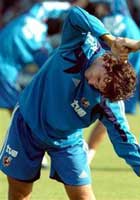

Back (Latissimus Dorsi & Teres Major)




Buttock (Gluteus Maximus, Medius & Minimus)
The muscles on your buttocks (glutes) work along with your hamstrings and quads to draw your leg backward and to extend it forward.
Your glutes also affect a wide range of hip motion including rotation, adduction and more.
If you have weak glutes, you'll have difficulty controlling your hip and thigh movement.
Your body will compensate by using other muscles, but your movements will be weaker and you'll be at higher risk for injury.
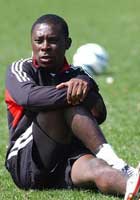
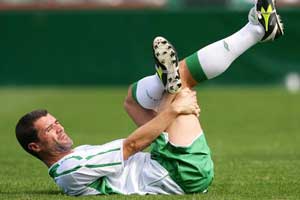
Quadriceps (Rectus Femoris, Vastus Lateralis, Intermedius & Medialis)
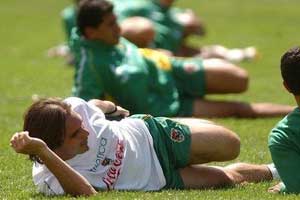
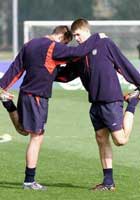
Hip flexor/rotator (Iliopsoas & Sartorius)
Iliopsoas or hip flexor is a group of muscles connecting the pelvis and lower spine to your hip bone.
The Iliopsoas flexes the hip forward, in conjunction with other muscles from the inner and front thigh. Therefore, the hip flexor is crucial in virtually all kicking techniques and spraining it will cause sharp groin pain, whenever you try to lift your leg up. The hip flexor also acts to move the top of the pelvis forward and not stretching it may sometimes cause lower back pain.


Groin (Gracilis, Adductor Brevis, Longus & Magnus)
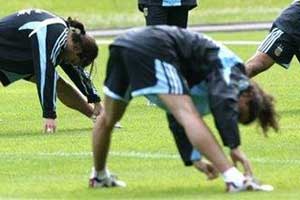

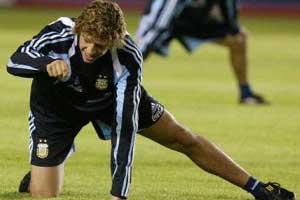
Hamstring (Biceps Femoris, Semitendinosus, Semimembranosus)
The hamstring is a group of muscles on the back of your thigh.
It is responsible for bending or flexing your knee, while the quadriceps straightens it.
Hamstrings and glut muscles are crucial for explosive acceleration.
Having strong and flexible hams results in a longer running stride and also lessens the effects of fatigue that affect your form over time.
The hamstring is the most frequently strained muscle in soccer.
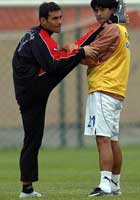
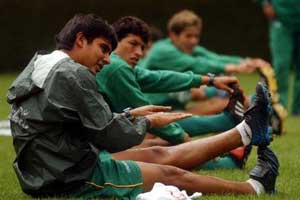
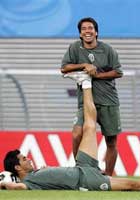
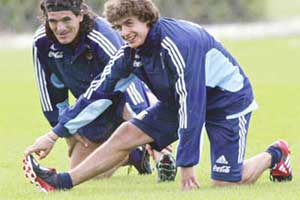
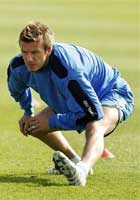
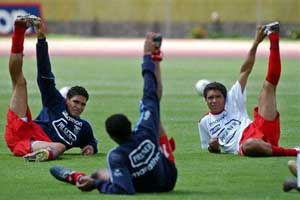

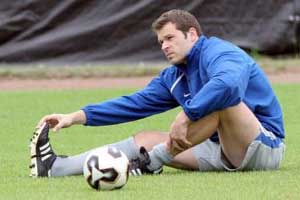
Calves (Gastrocnemius)
Calves are the muscles on the posterior of your lower leg. Your calves are responsible for "stabilizing" your ankles every time you touch the ground. They also play a significant role in rapid change of direction and deceleration. If your calves are weak you may experience ankle problems or extra strain on your quads.
Aerobic training
During aerobic activity, your body supplies the muscles with most of the oxygen lost during work. The muscles require oxygen for the oxidation of fat and carbohydrates. In order to maintain this balance and keep the muscles supplied with oxygen, the rate of exercise must be between 50-75% of your maximum heart rate. If the exercise becomes too intense, the heart is not able to provide the muscles with the needed oxygen so they will switch to alternative sources of energy. Beyond this point, any further activity is considered anaerobic.
Aerobic ability is determined by the maximum amount of oxygen that your body can consume, or VO
2 max. VO
2 max is largely dependent on the efficiency of your body's "oxygen transport system".
Jogging
Jog over 3000 meters (2 miles) at 50-60 percent, preferably on grass or a running track. Jogging for periods of over 20-30 minutes improves your cardiovascular system and capillarisation. Furthermore, jogging develops your heart as a muscle. To stay fit as a soccer player, especially during the off-season, you need to go out for a jog at least once every 2-3 days.
The technique for jogging is slightly different compared to that of sprinting. Contact the floor with the area from the middle of the foot to the heel and shift the weight up to the toes. Drive your arms parallel to the direction you are facing. If your head seems to move up and down (or from side-to-side) a lot, then you are not jogging efficiently.
Next time you hit the track, bring a stopwatch along to see how you stack up against these international records:
| Distance |
Record time |
| Laps |
Km |
Miles |
Men |
U19 |
U18 |
U17 |
U16 |
U15 |
U14 |
U13 |
Women |
| 1 |
0.400 |
~0.25 |
00:43 |
00:43 |
00:44 |
00:44 |
00:45 |
00:45 |
00:46 |
00:48 |
00:47 |
| 2 |
0.800 |
~0.5 |
01:40 |
01:43 |
01:44 |
01:45 |
01:47 |
01:49 |
01:51 |
01:56 |
01:53 |
| 2 ½ |
1.000 |
~0.62 |
02:11 |
02:16 |
02:18 |
02:18 |
02:20 |
02:26 |
02:29 |
02:34 |
02:28 |
| 3 |
1.200 |
~0.75 |
| 4 |
1.600 |
~1 |
| |
~1.609 |
1 |
03:43 |
03:51 |
03:53 |
03:57 |
04:06 |
04:08 |
04:19 |
04:29 |
04:12 |
| 5 |
2.000 |
~1.25 |
04:44 |
04:59 |
05:06 |
05:15 |
05:19 |
05:24 |
05:24 |
05:37 |
05:25 |
| 6 |
2.400 |
~1.5 |
| 7 |
2.800 |
~1.75 |
| 7 ½ |
3.000 |
~1.86 |
07:20 |
07:43 |
07:47 |
07:56 |
07:56 |
08:13 |
08:24 |
08:40 |
08:06 |
| 8 |
3.200 |
~2 |
| |
~3.218 |
2 |
07:58 |
08:25 |
08:34 |
08:34 |
08:45 |
08:57 |
09:15 |
09:41 |
08:58 |
| 9 |
3.600 |
~2.25 |
| 10 |
4.000 |
~2.5 |
| 11 |
4.400 |
~2.75 |
| 12 |
4.800 |
~3 |
| 12 ½ |
5.000 |
~3.1 |
12:37 |
13:22 |
13:25 |
13:45 |
13:45 |
14:10 |
14:49 |
15:33 |
14:11 |
Cooper's test
Run for exactly 12 minutes on a track so you can measure the distance you have covered. Ideally, you should be able to complete at least 8 laps (3200 meters or about 2 miles) within the allotted 12 minutes. Push yourself in each session and try to improve on your best distance.
Running uphill or on sand
Run over 1500 meters (1 mile) on sand or an inclined surface. Intensity should be between 60-80 percent. An intense run between 1-2 miles improves glycogen burning as well as lactate tolerance and removal. These are chemicals that accumulate in the muscles and cause fatigue.

Anaerobic training
Any short, intensive activity between 70-100% of the maximum heart rate is considered anaerobic.
"Anaerobic" literally means: "without air".
During anaerobic exercise the body supplies itself with energy from stored sources (like Glycogen) as opposed to oxygen.
In the process, lactic acid is formed in the muscles causing fatigue and discomfort.
Anaerobic endurance refers to an athlete's ability to sustain intense activity and recover quickly.
This generally depends on the body's lactate tolerance and removal.
Overall, anaerobic training will help you recover quicker and consistently sprint at top speed.
Anaerobic training involves consecutive intervals of intense activity followed by rest or less-intense activity.
In the course of a soccer match, players perform a number of short sprints separated by longer periods of jogging.
Therefore, anaerobic conditioning is particularly relevant to soccer and is an effective way to get fit.
Speed and agility training
Soccer involves many short bursts of sprinting so it's good to incorporate that in your training routine.
Try to complete a set of 15 to 30 sprints every other time you practice and watch your top speed increase over time.
Speed training is all about stressing your muscles to the max so it's vital to rest after each session.
Muscles regenerate on the day after the actual exercise, so workouts should be limited to 2-3 times per week at most.
Speed training is best performed on a soft surface like grass.
This makes it easier on your joints and lowers the risk of injury.
References and further reading
Conditioning for Soccer by Joe Luxbacher
Soccer Techniques, Tactics & Teamwork by Gerhard Bauer
International Age Records by Dominique Eisold
Photographs courtesy of
fifa.com

























